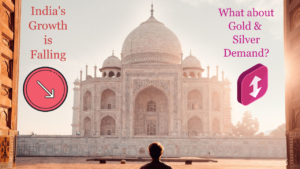
According to the latest data released by India’s government, its economy has grown at its slowest pace in almost five years.
In the past financial year – April 2018 to March 2019 – the economy grew by 6.8%. And in the quarter between January and March, it expanded by just 5.8% – falling behind China’s pace for the first time in nearly two years.
This means India is no longer the world’s fastest-growing economy.
One of the most pressing challenges for the country is job creation.
The biggest criticism of Prime Minister Modi, during his first term, was his government’s failure to generate employment, in fact, unemployment touched a 45-year high between 2017 and 2018.
Many are asking, now that Narendra Modi has won a second term with a landslide, what is he going to do about it, especially as the new GDP data make it clear, that India is staring at an economic slowdown.
Unlike China, Over the past 15 years, India’s economic growth has been driven by domestic consumption, but recent data suggests that consumer spending is slowing.
Sales of cars and SUVs have slumped to a seven-year low. Tractor, motorbike and scooter sales are down. Demand for bank credit has struggled to say the least.
Mr Modi’s Bharatiya Janata Party (BJP) promised that it would cut income tax to ensure greater purchasing power. But India’s 3.4% budget deficit – the gap between government expenditure and revenue – might restrict his options, especially as experts agree that the widening fiscal deficit could hold back medium- and long-term growth.
With more than half of India’s population relying on farming one should not be surprised at the effectiveness of farmer’s lobbying power. An example was during Mr Modi’s first term where Farmers across the country regularly protested, demanding higher crop prices and loan waivers. This has resulted in Modi’s Party promising to extend a scheme that offered income support for small- and medium-sized farmers to include all farmers.
Having said that, one of the BJP’s biggest pledges was to spend $1.44tn (£1.14tn) to build roads, railways and other infrastructure. But many observers say that this enormous commitment will have to come from private industry, and this is likely to cause Mr Modi to adopt an aggressive privatisation policy in order to afford it.
Another issue has been Private investment which has lagged for the past few years, as India’s impressive economic growth in the past decade has largely been driven by government expenditure.
This has to change, and policies need to be enacted to prove attractive to foreign investors which is why we believe privatisation is most definitely on the cards.
That said, it was announced only Friday, that The US will end preferential trade status for India next week, amid a deepening row over protectionism.
India had been the largest beneficiary of a scheme that allows some goods to enter the US duty-free.
However, that status will end on Wednesday, President Trump said Friday.
It was back in March that he announced that it would be revoked because India had failed to provide adequate access to its markets and on Friday the President stated “It is appropriate to terminate India’s designation as a beneficiary developing country.”
This preferential trade treatment for India allowed some $5.6bn worth of exports to enter the US duty free. In fact, President Trump did the same thing to Turkey only last month, in an attempt, according to the Trump administration, “to redress unfair trading relationships with other countries.”
So how likely is this going to affect India’s economy? Well it certainly cannot help. Having said that India currently exports some $83 billion worth of goods and services to the US so $5.6bn is frankly small potatoes.
Having said, that with economic growth slowing, India will be looking to expand its export base rather than see it diminish, which higher prices undoubtedly will cause. This is why it is imperative that Modi look at either privatisation or some other form of capital generating programmes to boost economic growth.
So, what impact could this have of India’s gold demand. Well in 2018 its demand for gold fell by 1% 760.4 tonnes compared to 771.2 tonnes in 2017 – though many had predicted it would be much larger.
Much of the reason was in fact the fall in the value of the rupee and therefore the higher cost of gold. It appears though that demand for the first quarter of this year is robust especially for gold jewellery with demand the highest for the quarter since 2015.
By contrast, India’s consumption of silver jewellery jumped 16 % in 2018 to 76.5 million ounces and Purchases of silver investment bars in India, surged by 160% to 69.4 million ounces. Of course, silver being substituted for gold as it became much more affordable by contrast.
Now certainly gold demand could be in jeopardy if the economy slows down. We frankly are not convinced that it will dramatically slow at this period in time as we have confidence that modi will adopt measures to boost the economy.
Admittedly easier said than done in a global situation of lower growth, and countries such as the US adopting protectionist trade measures. Nevertheless, the Indian economy is still relatively primitive in terms of financial sophistication and therefore has an opportunity to maintain its high levels of growth even if only achieved through domestic consumption initially via infrastructure spend.
So, our analysis for the moment is not to fear any major restrictions in gold and silver demand from India for the foreseeable future, however, of course any further decrease in global trade and growth will inevitably have an impact eventually.


Leave A Comment
You must be logged in to post a comment.